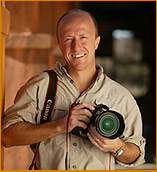

It's not very often that we in the "developed world" think about the importance of light. Light is something we take for granted....except maybe 1 time every year when the power goes out, for maybe an hour or two...But did you ever stop to think about the Two billion people living in the developing world that must rely on kerosene lanterns, candles, and single-use battery flashlights for light at night? Well Mark Bent did.
I met Mark at the InterAction Forum, a meeting of NGOs that takes place in Washington DC. Mark was at a small booth displaying his new BoGo light, a battery operated, solar charging flashlight. His vision was to bring light to those who most need it but can least afford it. Mark wanted to make positive change in the world, and he's doing it!

Mark Bent invented the BoGo light. I was so impressed with what he's doing I said "hey Mark, how about you give me a BoGo light, and I'll take it on one of my trips to a remote area, take some photos of it in use and then I'll leave it with the person or family I photograph". Mark said "sure" and handed me a BoGo light. Well, I thought I was just going to drop of a BoGo light and snap a few shots, but what I ended up with was a real-world, first hand education about how important light is, and what a great thing Mark is doing! Since that first meeting, I have become a great fan of the Bogo Light. This little product is making a big difference!
(text below copied from Mark's website)
About
two billion people living in the developing world rely on kerosene lanterns,
candles, and single-use battery flashlights for light at nightNot only are
these options expensive, dangerous, and harmful to the environment, they also
negatively impact health, education, and security. Lights provide an opportunity
for children to read at night and to extend school hours. This is especially
important in developing countries where most children spend all day tending
crops, taking care of livestock, or working in cottage industries. Kerosene
is increasingly expensive, especially given the recent rise in the price of
petrochemicals, so many families cannot afford it. Flashlights are even more
expensive, and candles do not provide adequate lighting to read. As a result,
many children will never learn to read and will be trapped in a life of poverty.

Something as simple as a BoGo light gives them a chance at a better life! The above photo is one I took of two school children in rural Cambodia doing homework using the BoGo light.
Now Mark has a new product, the SL2-Super Bogo....it's a new and improved version...
The SL-2 Super BOGO light is intended to be a rugged, long life, solar rechargeable light whose primary purpose is for kerosene lantern replacement and task lighting in "developing world" applications. It's design brief was to provide wide angle illumination with more usable light than a kerosene "bottle lantern", for use in rooms up to 4 x 4 meters or as a study or work lamp over a table. In a kerosene lantern replacement role it can save users in excess of 20 to 30% of their disposable incomes while eliminating fine carbon particle inhalation (one cause of "hut lung") and eliminating injuries from burns due to kerosene spillage.
And with hydrocarbon prices skyrocketing, kerosene prices are also way up, which makes the Super BoGo even better!
With a fully charged original battery the SL-2 will typically operate for 4 to 5 hours on full power, about twice that on its medium power settings and 4 times as long on low power. The BoGo light uses a high efficiency polycrystalline silicon phototovoltaic panel (or PV panel or 'solar panel') to charge its batteries. It takes 8 to 10 "sunlight hours" (hours of direct full sunlight) to charge the supplied 800 mAh batteries. In African summer conditions a full charge will be able to be achieved in a single day.On full power users get about 30+ minutes of lighting per sunshine hour. On medium power they get about 1 hour of operation per sunshine hour. And on low power, about 2 hours operation per sunshine hour. So with 2 to 3 sunshine hours in a day a user can expect 4 to 6 hours of low level but useable light.

If you purchase a BoGo light for yourself, Mark will send another to a needy person overseas, and you get to choose where! Click here for the BoGo Light website. Why not do yourself (and someone else, less fortunate than you) a favor and buy one now!
Way to go Mark, you and the BoGo light are making a difference in the world!
.